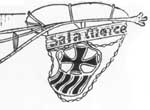|
|
|
||||||||||||||||||||
|
|||||||||||||||||||||||
 Joke from a newspaper of the epoch JOIN OUR CLUB!!! Register here as a new member if you want to be advised by e-mail on new updates, and take your FREE WELCOME GIFTS. |
The
Sala Mercè
(1904-1913) Pioneer hall in the cinematography of Barcelona After he had traveled to the United States where he had perceived the beginning success of cinematography, the painter Lluís Graner Arrufí (1863-1929) decided to create a projection hall in Barcelona at the beginning of century XX. He assigned the project to his friend Antoni Gaudí, who later would design a country house for the painter, which nevertheless never got build. Projected as a spectacle local, the Sala Mercè -called this way in honor of the “Virgen de la Merced”, patroness of Barcelona-, was located at the ground floor of number 4 -today, 122- of the Rambla de los Estudios. The very old building belonged to family Fontcuberta. The Sala Mercè consisted in a vestibule, a waiting room and a spectacle hall. Gaudí and Graner modified the doors of the Rambla and transformed them into two great bows through which you one could enter the vestibule, where there were two ticket offices. The first one was an authentic office window and the other one contained an automatic devil which said to the people “You mortals laughing with me, you will all come to me”. Once passed the ticket office, you entered the waiting room, rectangular and perpendicular to the street. The entrance to the spectacle hall was on the left and at the back there was a ramp that leaded to the below ground, where later would be located the “Fantásticas Covas” or the “Grutas Fantásticas en el Grandioso Subterráneo” – as the advertisement would say. A railing of 1.40 m height with bancs on one side separated the ramp from the waiting room, from which you could see the visitors that would go down the caves. The vestibule and the waiting room were decorated en light tones contrasting with the darkness and the rocky decoration of the spectacle hall with the light tones of its “earth” and “cooked mud” colored walls. The electric lights in the waiting room were covered with tulles or papers of different colors. The light bulbs of the projection hall, also covered with colored papers, were dissimulated between some cavities. The results ware some “incandescent changing spotlights of different tones”, following the press articles of the moment. In those days when spectacles were still performed in enlightened halls, the darkness offered by the Sala Mercè -which assured that the audience would not be distracted by anything else but the performance- must have created an enormous impact. This is confirmed by all the press articles about the grotto aspect of the local at the time. The projection hall was rectangular, three times longer than wide –approximately 8m x 22 m-, and located parallel to the Rambla. According to the description of Father Baldelló, musician and friend of Gaudí, “the whole hall had the disposition of a modern hall, with its pavement and vault perfectly visible thanks to its position. The walls and the vault were made of a very rough material and presented soft waves responding to a perfect audition system(…) The pavement of the hall was covered with step and each step corresponded to a row of seats. The seats were adjustable and made of iron and the seating were covered with a fabric of vegetal elements”. On top of the socle, about 1.80 m height, there was a unique decoration on the walls consisting in a border with vegetal motives crowned with a double wave. In the Catalan humoristic scenario “Cu-Cut!”, Virolet wrote that “thanks to the design of Mr. Gaudí, the hall was extremely well ventilated. One didn’t feel where the air entered neither how it renovated itself, it would circulate handsomely and not allow the atmosphere to go bad”. [“Cu-Cut!”, Year III, nº 150, Barcelona November 10th 1904, pp. 728-729. Call by Tokutoshi Torii from “El mundo enigmático de Gaudí”, Vol. I, p. 256]. Baldelló continues: “The frame of the screen and the small scene scenario were treated with the same material as the vault and the walls of the hall”. The actors and musicians who provided the spectacles with sound were hidden behind the proscenium. The spectacles always offered a varied repertoire and lots of humor and were very appealing to any kind of audience. They were structured in two parts: 1) Cinematography program: - “Animated films”: Deaf cinema: programmed until August 15th 1905 - “Voice Projections”: Movies filmed explicitly for this spectacle, in which the presenters hidden for the audience declaimed the dialogues of the movie actors. Later there were also offered “Portraits of artists or cultural personalities”. They have been programmed until October 1907. At the beginning of November they were forbidden because the hall was not secure enough. 2) “Musical visions”: Paintings projected on the screen, combined with light shows and special effects and accompanied with lyric chants and music. Some of the choral shores were composed by Graner himself. The Sala Mercè
was pioneer in the history of cinematography of Barcelona. Thanks
to the idea of integrating art, Lluís Graner was surrounded
by outstanding cultural figures of the moment. Scene directors such
as Salvador Alarma Tastàs, Félix Urgellés de
Tovar and Maurici Vilomara Virgili; musicians such as Enric Morera
or Joaquim Pecamins, sculptors such as Lambert Escaler; or writers
such as Miquel Costa i Llobera participated in some of the 43 performances
that were programmed. |